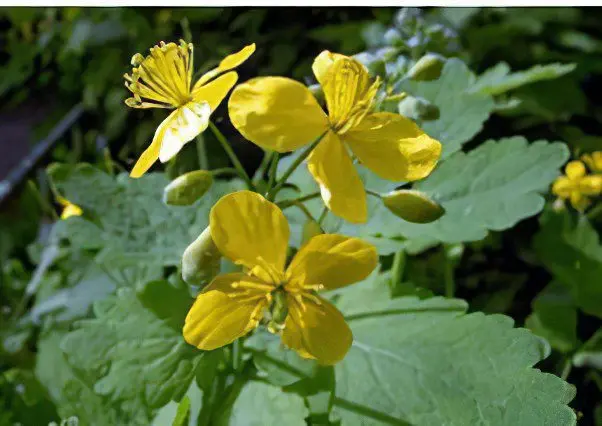The celandine plant belongs to the poppy family and the genus Dicotyledonous. It is a tall perennial herbaceous shrub with a hollow stem and lyre-shaped dark green leaves. Celandine blooms with yellow flowers, and then in their place small pods ripen, which crack in two and throw out seeds. The plant bears fruit 2-3 times during the summer, so it multiplies effectively and is found almost everywhere.
Science knows two types of celandine:
Chelidonium asiaticum – Asian (30-50 cm tall);
Chelidonium majus – large (50-120 cm tall).
Both types of plants are poisonous, but they have a number of useful properties, so they have long been actively used in both Eastern and European folk medicine. The Russian-language name of this herb speaks for itself – it “cleanses the body” from warts, acne and non-healing wounds. And the Latin name has a beautiful origin story: in the time of Avicenna, it was believed that swallows treat the festering and blinded eyes of their chicks with bitter celandine juice. Hence the term Chelidonium (literally “swallow”). In ancient Rus’, the celandine had numerous characteristic nicknames: yellow milkweed, podtynnik, warthog, chistuha, dog soap.
The chemical composition of celandine

The leaves, stems, rhizomes and bitter milk of celandine contain:
Аскорбиновая кислота (витамин C) и каротин (витамин A);
Organic acids (malic, citric, succinic);
Essential oils, bitters, resins and saponins;
Natural antibiotics (phytoncides);
Poisonous alkaloids (chelidonine, sanguinarine, protopine, allocryptopine, coptisine).
Chelidonin and its derivatives deserve special attention: oxychelidonine, homochelidonine and methoxychelidonine. This alkaloid is a direct relative of morphine, which is not surprising, because celandine is a relative of the poppy. Chelidonin in small doses has an analgesic effect, and in large doses it causes convulsions and paralysis of the nervous system. The highest content of alkaloids in the rhizomes of celandine (up to 0,5%), however, the leaves of the plant are also poisonous, so cattle on pastures bypass it.
Useful properties of celandine and its application
With proper skill and care, with the help of celandine, many diseases can be cured.
Due to the complex and rich biologically active composition, celandine has a multilateral effect on the human body:
Anesthetic;
Antitumor;
bactericidal;
Antifungal;
Wound healing;
Spasmolytic;
Bile and diuretic;
Expectorant.
Celandine is used to treat diseases:
Skin – psoriasis, scabies, acne, warts and papillomas, fungal infections, eczema, burns, wounds and ulcers;
ENT organs and respiratory system – runny nose, bronchitis, tracheitis, laryngitis, tonsillitis, pneumonia, asthma, whooping cough, tuberculosis;
Gastrointestinal organs – gastritis, gastric ulcer, pancreatitis, cholecystitis, hepatitis, enterocolitis;
Joints and bones – rheumatism, sciatica, gout, osteochondrosis, arthritis and arthrosis;
nervous system – headaches, migraines, neuroses;
female reproductive organs – vaginitis, colpitis, cervicitis, endometriosis, cervical erosion.
In addition, celandine is used to relieve pain (dental, menstrual, articular) and inhibit the development of malignant tumors. The anticarcinogenic properties of this poisonous plant are now being actively studied, since it has been found that celandine tincture prevents the appearance of metastases.









